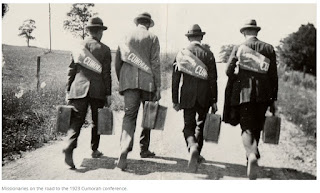Having previously served as assistant Church historian, Roberts selected the Eastern States mission because “it had the attraction of including within it the territory of the early activities of the church . . . and the coming forth of the Book of Mormon.”5After a general mission tour, President Roberts announced in 1923 an ambitious mission conference. With the permission of Pliny Sexton, all of the 140 missionaries scattered across 11 states gathered for three days in September at the Smith Farm and Hill Cumorah in honor of the centennial of Moroni’s first visit to Joseph Smith in September 1823. The missionaries were expected to preach along the way, wearing bright blue banners with “Cumorah” printed in bold, white letters. The conference was so successful that afterward an annual “Palmyra Celebration” was on the mission calendar.
 |
| Cumorah missionaries in 1923 |
|
Current explanation |
Corrected |
|
In the 1820s, the hill did not have a |
The historical record indicates that https://www.josephsmithpapers.org/paper-summary/lucy-mack-smith-history-1844-1845/41
|
THE HILL CUMORAH
George Anderson
Photographs
Cumorah is the hill and area recorded in the Book of Mormon where the Nephites and Lamanites fought a final battle in which the Nephite people were annihilated. Moroni reported that Cumorah was also the site where the Jaredites were earlier destroyed. In our era, the Hill Cumorah is a drumlin-hill between the towns of Palmyra and Manchester, New York, where the gold plates of the Book of Mormon, deposited by an ancient religious leader in a stone box, was unearthed, translated by the American Prophet, Joseph Smith Jr., and published in 1830. In 1928 the LDS Church purchased the site and in 1935 erected a monument commemorating the visit of the Angel Moroni. Later, the Church built a visitors center at the base of the hill. Since 1937, the Church has produced the annual outdoor Cumorah Pageant. This image looking southwest a century ago, was taken when the hill was less wooded than today.
THE HILL CUMORAH – George Anderson
Source: About Central America

